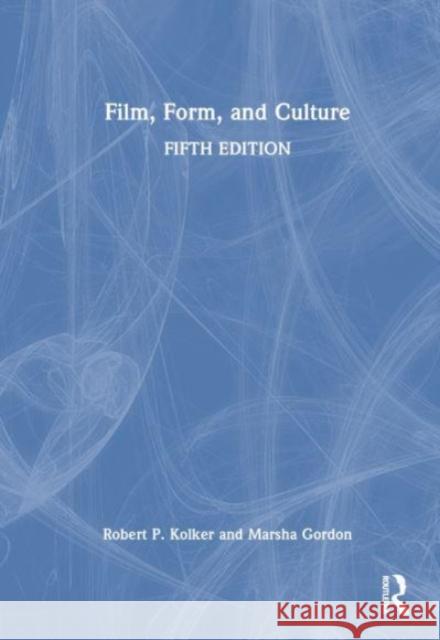Film, Form, and Culture » książka



Film, Form, and Culture
ISBN-13: 9781032505237 / Twarda / 2024 / 420 str.
Film, Form, and Culture
ISBN-13: 9781032505237 / Twarda / 2024 / 420 str.
(netto: 672,22 VAT: 5%)
Najniższa cena z 30 dni: 690,82 zł
ok. 22 dni roboczych
Bez gwarancji dostawy przed świętami
Darmowa dostawa!
This fifth edition of Film, Form, and Culture offers a lively introduction to both the formal and cultural aspects of film.
Wydanie ilustrowane
“I’ve taught Film courses for 20 years using Robert P. Kolker’s Film, Form and Culture, so I was delighted to see that Kolker has collaborated with Marsha Gordon to produce a 5th edition, which is a significant revision and expansion.
Kolker and Gordon persuasively argue that films must be taken seriously as the primary medium through which modern societies transmit their narratives and myths, in essence maintaining and extending culture.
The book offers three chapters on how movies are constructed, illustrating the principles of the art through a discussion of specific films. Most of the films under discussion are theatrically released American fictional works but attention is also devoted to documentaries and world cinema. The book presents cinema concepts like the two-shot, long take, three-point lighting, and over-the-shoulder cutting pattern in a manner that is equally interesting to casual movie-goers and future cinematographers. Kolker makes clear what is standard practice, how prior innovators have broken the rules and the success or failure of those deviations.
An additional three chapters are devoted to the history of film storytelling, focusing on the founding collaborators who created the studios, as well as the actors and the directors who created the work. While some biographical details are provided, the emphasis is on the work. There are abundant references to both the giants of the industry and their classical works like Hitchcock’s Vertigo and Psycho, Wells’ Citizen Kane, Curtiz’ Casablanca and It’s a Wonderful Life, Coppola’s Godfather and Apocalypse Now and the rest of the canon. At the same time, more recent works like Jackson’s Hobbit trilogy, the Toy Story and Hunger Games franchises, Spiderman, Black Panther and the rest of the Marvel Cinematic Universe all receive appropriate attention.
Contemporary producers and distributors like HBO and Netflix receive just as many citations as Paramount and Warner Brothers. The strengths and weaknesses of delivery media such as the movie theatre, television, videotape, DVD, 3D, and streaming services also are discussed, including the 2023 HBO series The Last of Us.
Three more chapters are devoted to the analysis of various film genres. Gangster, documentary, Western, science fiction, horror, film noir, and melodrama consume two chapters, with an additional chapter devoted to global films, in all of their varieties. The final chapter is devoted to the reciprocal relationship between film and various elements of culture, closing with additional exegesis of Vertigo.
Kolker and Gordon provide an outstanding introduction to film history, production and analysis. I am pleased that it will continue to be available for a new generation of students.”- Michael R. Cunningham, Professor, Dept. of Communication, University of Louisville, USA
Introduction 1. Image and Reality 2. Formal Structures: How Films Tell Their Stories 3. The Building Blocks Of Film I: The Shot and Its Elements 4. The Building Blocks of Film II: The Cut 5. The Story Tellers of Film I 6. The Storytellers of Film II: Acting 7. The Storytellers of Film III: The Director 8. Global Cinema 9. The Stories Told By Film I 10. The Stories Told by Film II 11. Film as Cultural Practice
Robert P. Kolker is Professor Emeritus at the University of Maryland, College Park, USA. He is the author/editor of several books on film including The Oxford Handbook of Film and Media Studies (2008), A Cinema of Loneliness, 4th edition (2011), The Cultures of American Film (2014), The Extraordinary Image: Orson Welles, Alfred Hitchcock, Stanley Kubrick, and the Reimagining of Cinema (2016), Politics Goes to the Movies (2018) and Eyes Wide Shut: Stanley Kubrick and the Making of His Final Film (2019).
Marsha Gordon is Professor and Director of Film Studies at North Carolina State University, USA. She is the author of Becoming the Ex-Wife: The Unconventional Life & Forgotten Writings of Ursula Parrott (2023), Film is Like a Battleground: Sam Fuller’s War Movies (2017), and Hollywood Ambitions: Celebrity in the Movie Age (2008), and co-editor of Screening Race in American Nontheatrical Film (2019) and Learning With the Lights Off: Educational Film in the United States (2012).
1997-2025 DolnySlask.com Agencja Internetowa
KrainaKsiazek.PL - Księgarnia Internetowa









